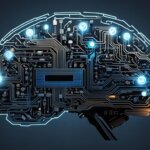Table of Contents
Robotics is an interdisciplinary branch of science that combines elements of electrical engineering, mechanical engineering, computer science, and more. It involves the design, construction, and operation of robots, which are machines programmed to perform tasks autonomously or with minimal human assistance. The field of robotics encompasses everything from the conception and mechanical design of robots to their control and sensory feedback. It is a vast field with applications in various industries, including manufacturing, healthcare, and defense. Understanding the basics of robotics is essential for anyone interested in this rapidly evolving field.
The Difference Between Robotics and Artificial Intelligence
While artificial intelligence (AI) and robotics are closely related, they are not the same thing. Robotics focuses on the physical motion and functionality of robots, including their design, construction, and control. It involves the integration of various engineering disciplines to create machines that can carry out tasks independently or with minimal human intervention. On the other hand, artificial intelligence refers to the intelligence exhibited by machines, which enables them to make decisions, learn from experiences, and adapt to new situations.
Many robots incorporate artificial intelligence to enhance their capabilities, but not all robots require AI to function. The distinction between robotics and artificial intelligence lies in the specific goals and functionalities of the machines involved. Robotics is concerned with the mechanics and operations of robots, while artificial intelligence is focused on enabling machines to exhibit intelligent behavior.
Robots can perform a range of tasks without artificial intelligence, such as automated manufacturing processes or repetitive actions. However, adding AI capabilities allows robots to analyze data, learn from patterns, and make decisions based on the information they gather. This integration of artificial intelligence in robots opens up opportunities for more advanced functionality, such as natural language processing, computer vision, and machine learning.
While robotics and artificial intelligence often intersect, they are distinct fields with different emphases. Robotics addresses the physical aspects of creating and controlling robots, while artificial intelligence focuses on enabling machines to exhibit intelligence and autonomous decision-making capabilities.
In the world of robotics, the aim is to develop machines that can execute tasks autonomously or with minimal human intervention. Artificial intelligence, on the other hand, aims to create intelligent machines that can perceive, reason, and learn from their experiences. By incorporating artificial intelligence into robotics, engineers and researchers are able to create robots that can perceive and interact with the world around them in a more intelligent and adaptive manner.
Artificial intelligence in robotics has led to significant advancements in fields such as autonomous vehicles, medical robotics, and companion robots. For example, self-driving cars integrate AI algorithms to navigate and make decisions based on real-time data. In the medical field, surgical robots equipped with artificial intelligence can assist surgeons during complex procedures, enhancing precision and safety.
The image below illustrates the relationship between robotics and artificial intelligence:
Key Points – Robotics vs. Artificial Intelligence:
- Robotics focuses on the physical aspects of creating and controlling robots, while artificial intelligence focuses on enabling machines to exhibit intelligence and decision-making capabilities.
- Not all robots require artificial intelligence to function, but adding AI capabilities enhances their capabilities and enables more advanced functionality.
- Robots without AI can perform automated tasks, while AI-powered robots can analyze data, learn from patterns, and make intelligent decisions.
- The integration of artificial intelligence in robotics has led to advancements in fields such as autonomous vehicles, medical robotics, and companion robots.
Types and Applications of Robots
Robots come in various types and are each designed for specific applications. Some common examples include humanoid robots, cobots (collaborative robots), domestic robots, industrial robots, and medical robots.
Humanoid robots are designed to resemble humans in both appearance and behavior. They are often used in research and entertainment industries. Additionally, cobots are specifically designed to work alongside humans in production processes. These robots are typically smaller, more flexible, and easier to program than traditional industrial robots.
Domestic robots, such as vacuum cleaners and lawn mowers, serve the purpose of assisting with household tasks. They are programmed to automate cleaning and maintenance activities, providing convenience for homeowners. On the other hand, industrial robots are commonly found in manufacturing industries where they are used for handling, assembly, and processing workpieces, improving efficiency and productivity.
Medical robots play a crucial role in healthcare settings, performing tasks such as surgery and rehabilitation therapy. They help enhance the precision and accuracy of medical procedures, ultimately improving patient care and safety. The applications of robotics extend across various industries, including manufacturing, healthcare, agriculture, disaster response, and entertainment. From revolutionizing manufacturing processes to transforming the way surgeries are performed, robots have become indispensable in modern society.
FAQ
What is robotics?
Robotics is an interdisciplinary branch of science that combines elements of electrical engineering, mechanical engineering, and computer science. It involves the design, construction, and operation of robots, which are machines programmed to perform tasks autonomously or with minimal human assistance.
What is the difference between robotics and artificial intelligence?
Robotics focuses on the physical motion and functionality of robots, including their design, construction, and control. On the other hand, artificial intelligence refers to the intelligence exhibited by machines, enabling them to make decisions, learn from experiences, and adapt to new situations. While robotics involves the physical aspects of robots, artificial intelligence is concerned with the cognitive capabilities of machines.
What are the types and applications of robots?
There are various types of robots designed for specific applications. Some common types include humanoid robots, cobots, domestic robots, industrial robots, and medical robots. Humanoid robots resemble humans in appearance and behavior and are used in research and entertainment. Cobots work alongside humans in production processes. Domestic robots assist with household tasks. Industrial robots are used in manufacturing for handling, assembly, and processing workpieces. Medical robots assist in healthcare, performing tasks such as surgery and rehabilitation therapy. Robots find applications in industries such as manufacturing, healthcare, agriculture, disaster response, and entertainment.







